Gisteren was het een echte museumdag voor mij.
Ik bezocht musea in Amsterdam en een tentoonstelling
in de universiteitsbibliotheek van Leiden:
Sanskrit – Asia and Beyond.
In het Nederlands: Sanskriet, in Azie en ver daar buiten.
Het is geen eenvoudige tentoonstelling voor een leek.
Maar de kans om prachtige oude manuscripten te kunnen zien,
komt niet zo vaak voor.
Er was een prachtige leporello te zien en een paar
boeken van palmbladeren.
Van die laatste ben ik nu al weer een tijd aan het proberen
te achterhalen hoe dat nu precies in elkaar zit.
Jammer dat er geen uitgave bij de tentoonstelling is.
Al was het maar een paar A4-thes met de teksten van de tentoonstelling
(misschien zelfs in het Nederlands) en een paar foto’s van de voorwerpen.
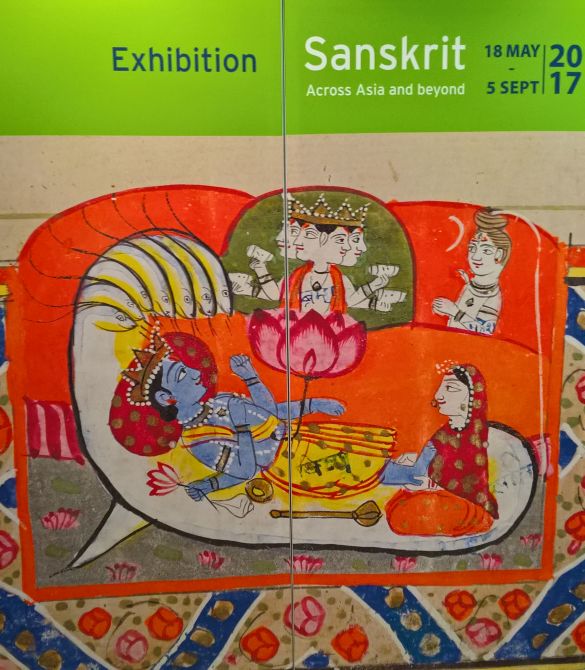

Het eerste voorwerp dat mijn aandacht trok was meteen een boek van palmbladen: Manuscript of the Sivadharmasastra, palm leaf, Grantha script, South India, 1830.
De tentoonstelling vertelt over verschillende adpecten van het Sanskriet.
Volgens de makers van de tentoonstelling is Sanskriet voor Azie
wat het Latijn was voor Europa: de taal van de wetenschap, religie,
machthebbers en de verhalen.
Over de boeken en andere voorwerpen is het moeilijk informatie
te vinden op het internet.
Is het ‘Sivadharmasastra’ of ‘Siva Dharmasastra’ of ‘Śivadharmaśāstra’?
Over het ‘Grantha ‘ schrift zegt Wikipedia:
The Grantha alphabet (Tamil: கிரந்த எழுத்து, translit. Kiranta eḻuttu; Malayalam: ഗ്രന്ഥലിപി; Sanskrit: ग्रन्थलिपिः, translit. grantha lipi) is an Indian script that was widely used between the sixth century and the 20th centuries by Tamil and Malayalam speakers in South India, particularly in Tamil Nadu and Kerala, to write Sanskrit and the classical language Manipravalam, and is still in restricted use in traditional Vedic schools (Sanskrit veda pāṭhaśālā). It is a Brahmic script, having evolved from the Tamil-Brahmi. The Malayalam script is a direct descendant of Grantha, as are the Tigalari and Sinhala alphabets.
Hele korte samenvatting:
Het Grantha alfabet is een Indiaas schrift dat tussen de 6de en 20ste eeuw
werd gebruikt door mensen die Tamil of Malayalam spreken in Zuid India.
Met name in Tamil Nadu en Kerala werd het gebruikt om Sanskriet en de
klassieke taal Manipravalam te schrijven.
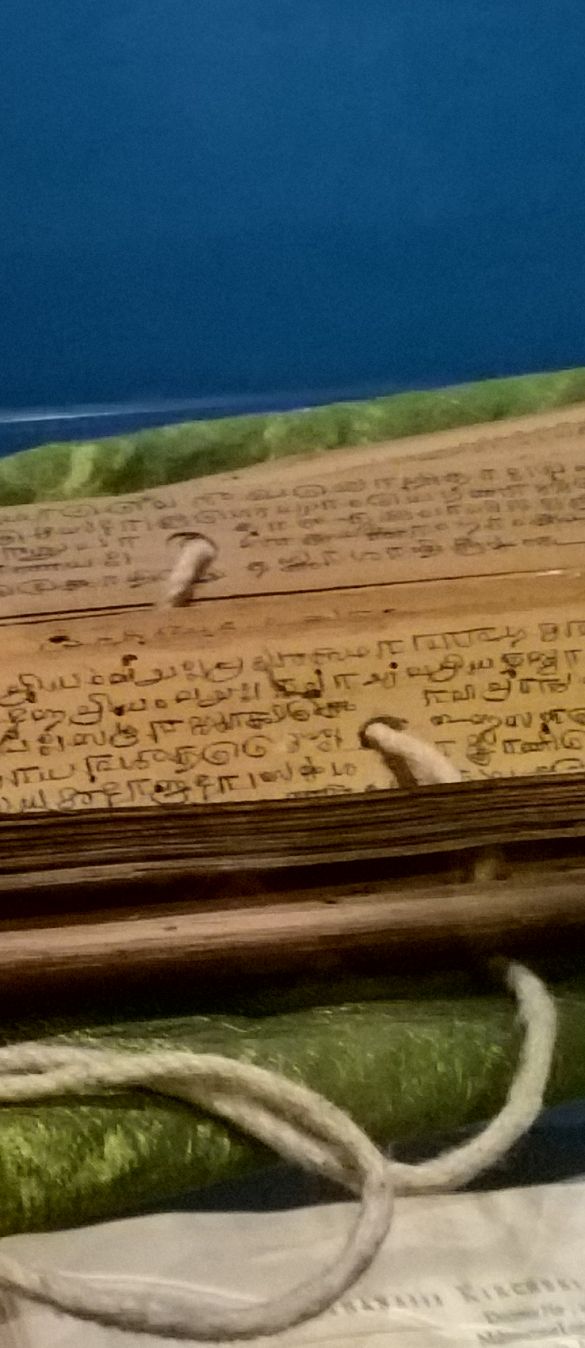
Manuscript of the Sivadharmasastra, palm leaf, Grantha script, South India, 1830. Detail.

Manuscript of the Sivadharmasastra, palm leaf, Grantha script, South India, 1830. Detail.
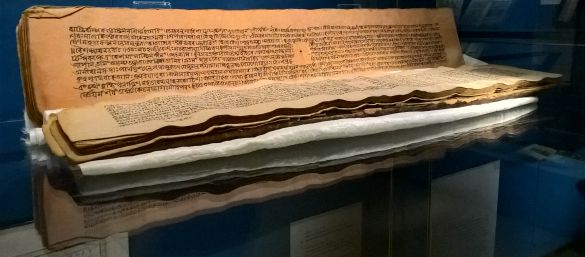
Manuscript of the Mahabharata, paper, Bengali script, Bengal, circa 19th century.

Dit is een voorbeeld van hoe in de vitrines de verschillende voorwerpen worden verklaard. Hier ‘Talen en Schriftsoorten’.
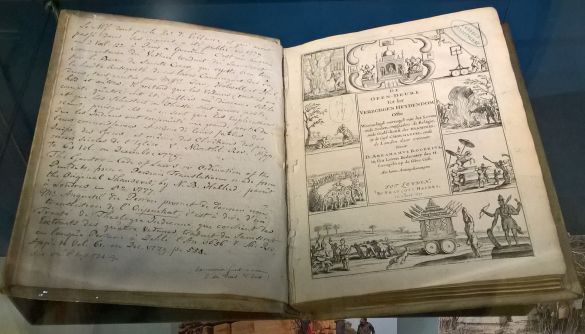
De bestudering van het Sanskriet kent een wetenschappelijke traditie waarbij stil gestaan wordt. Hier zien we een versie van het boek ‘De open-deure tot het verborgen heydendom’ door D. Abrahamus Rogerius. De drukker van dit boek was Françoys Hackes of Franciscus Hackius. Drukker in Leiden van 1638-1655. Dit boek is uit 1651.
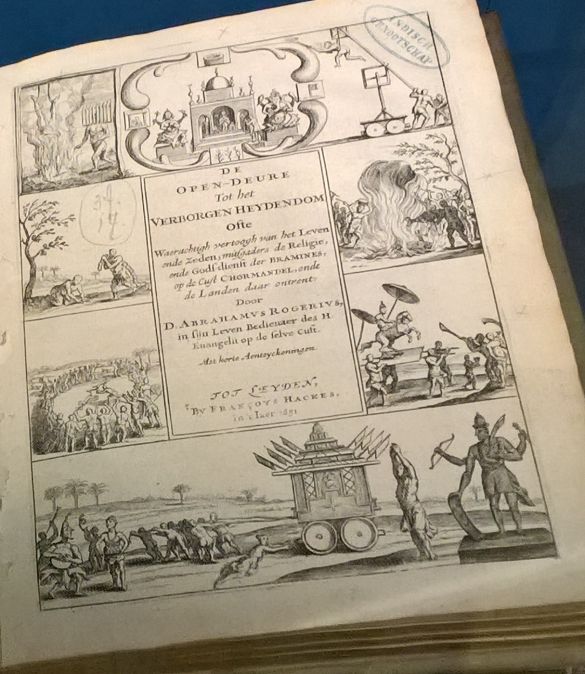
Het prachtige titelblad van ‘De open-deure tot het verborgen heydendom’ door D. Abrahamus Rogerius
Wikipedia (helaas in het Engels):
It is possible Abraham was born in Haarlem, like his brother Jacobus, also a chaplain, who went to the Indies. The Calvinist Rogerius (anglicized as Roger), studied in Leiden under Antonius Walaeus. His first trip was to Batavia (1631) and then Surat (1632). From 1633 he worked as a chaplain in Pulicat, the capital of Dutch Coromandel. He studied Hinduism in southern India and learned Portuguese. Rogerius authored Open Door to the Secrets of Heathendom, which begins with ten years of ministry among the Tamil people in the Dutch colony of Pulicat near Madras, India. His knowledge came from three Brahmins whom he met regularly. In 1642 he went back to Batavia and became the manager of an orphanage/school and promoted the use of Portuguese during church services. In 1647 he returned to the Dutch Republic.
“De Open-Deure tot het verborgen Heydendom ofte Waerachtigh vertoogh van het leven ende zeden, mitsgaders de Religie ende Gotsdienst der Bramines op de Cust Chormandel ende der landen daar ontrent (“The open door to the hidden paganism or truthful account of life and customs, as well as religion and worship of the Brahmins at Coromandel Coast and surrounding countries “), which was published in Leiden in 1651 and since translated into German (1663), French (1670). This book was one of the first European books describing hinduism. The book has two parts. The first deals with the Brahmins life and customs, while the other describes their faith and worship. Rogerius seems to have been the first published a translation of aphorisms in Sanskrit by Bhartṛhari, (Hundred aphorisms on the path to heaven by the heathen Bhartṛhari, famous amongst the Brahmins on the Coromandel coast) which forms the third part of the book.
Belangrijkste feiten in de tekst hierboven:
Abraham Rogerius was een Calvinistische predikant.
Ging in 1631 naar Batavia en in 1632 naar Seurat.
Van 1633 werkte hij in Pulicat.
Daar bestudeerde hij het Hindoeisme.
zijn boek ‘De Open-Deure tot het verborgen Heydendom’
was een van de eerste boeken in Europa over Hindoeisme.
Het werd in 1663 in het Duits en in 1670 in het Frans vertaald.
Het boek bestaat uit drie delen. Deel 3 bevat een vertaling
van aforismen die origineel in Sanskriet geschreven waren.
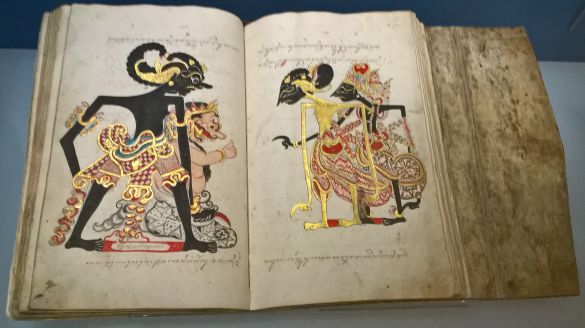
Illuminated volume of Wajang Purwa plays Kandhi Ana and Minta Raga, Javanese language and script, Java, 1863. Met die prachtige extra flap aan het boek (rechts).

De linkerpagina van het boek op de vorige foto: Wajang Purwa plays.
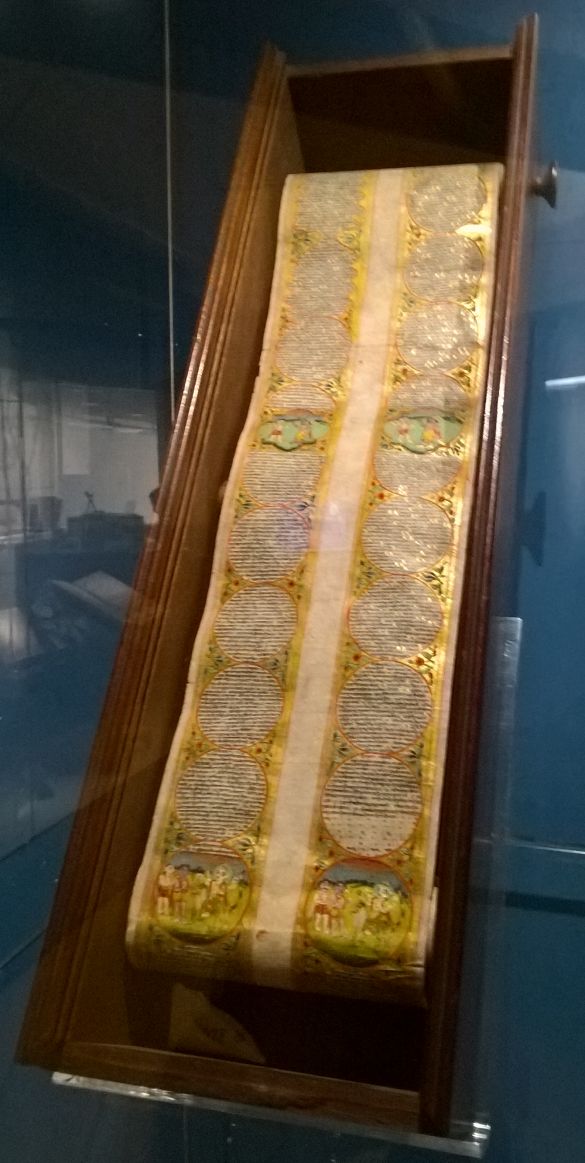
Een wel heel bijzondere uitvoering van een boek: op rollen in een houten kist. Illuminated manuscript of the Devimahatmya, paper on roll in wooden box, North-West India, 19th century.
Wikipedia:
Devi Mahatmya (Sanskriet, IAST: devī māhātmyam, letterlijk: “glorie van de godin”), Durga Saptashati (Sanskriet: durgā saptashatī, “700 verzen voor Durga”) of Chandipatha (Sanskriet: caṇḍī pāṭha) is een hindoegeschrift uit de 5e of 6e eeuw. Het is de oudst bekende hindoeïstische tekst waarin waarin god aanbeden wordt als vrouw. In oudere hindoeïstische teksten komen wel vrouwelijke goden (godinnen) voor, maar deze hadden een ondergeschikte rol. De Devi Mahatmya is onderdeel van de Markandeya Purana, een van de zogenaamde Purana’s, en is opgesteld in het Sanskriet.
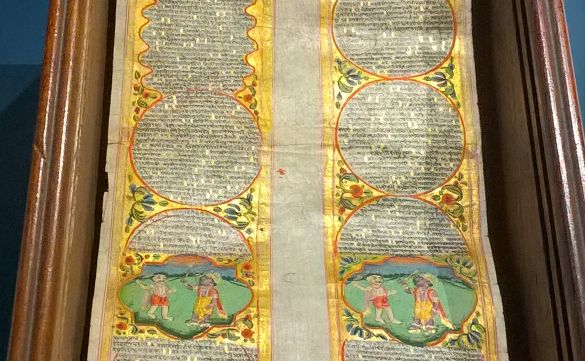
Het viel niet mee mooie foto’s te maken door de vitrines. Maar dit is een heel bijzonder boek. Een prachtige uitvoering. Illuminated manuscript of the Devimahatmya.
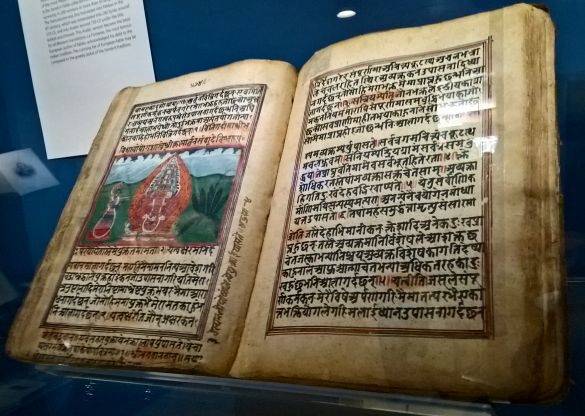
Illuminated volume of the Bhagavadgita, paper, Devanagari script, North India, circa 19th century.

Detail met de illustratie van de vorige foto. Illuminated volume of the Bhagavadgita in Devanagari script.

Leaf from an illuminated Bhagavatapurana manuscript, Urdu in Arabic script, North India, circa 19th century.
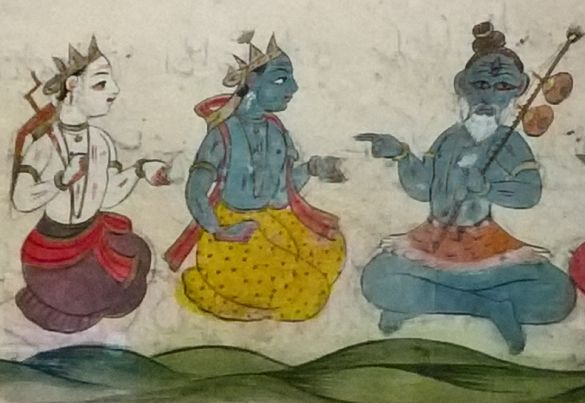
Detail van de vorige foto. Een soort ‘hij heeft het gedaan’.

De afbeelding paste niet helemaal in het kader. Dan pas je natuurlijk gewoon het kader aan.
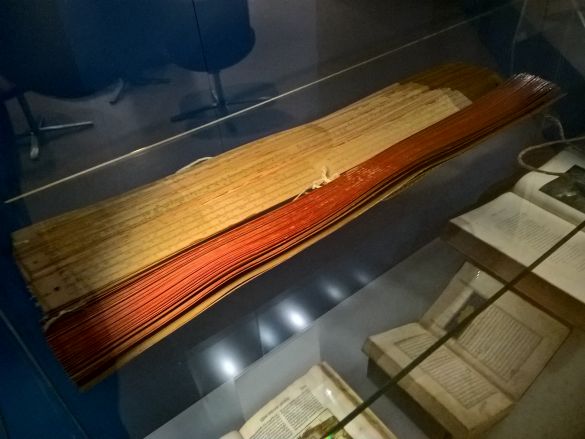
Ik had het vermoeden dat boeken van palmbladen altijd klein en handzaam zijn. Niet dus. Manuscript of the Ramayana, lontar (lontar is een Indonesische term voor palm leaf manuscript), Javanese language in Balinese script, Bali, 1807.
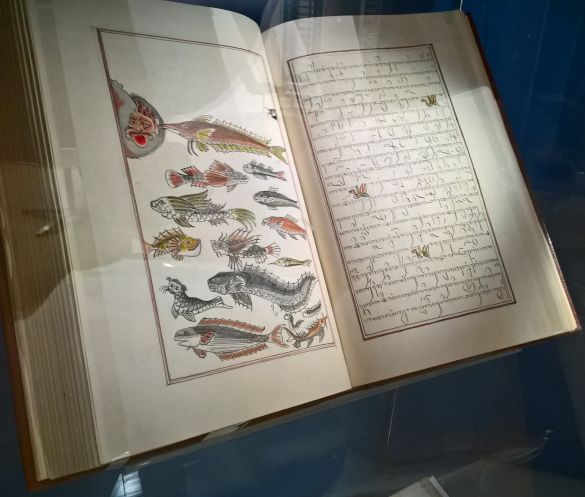
Leather bound volume of the Adi Darma Sastra and Adidumastra, Javanese language and script, Java, 1900.
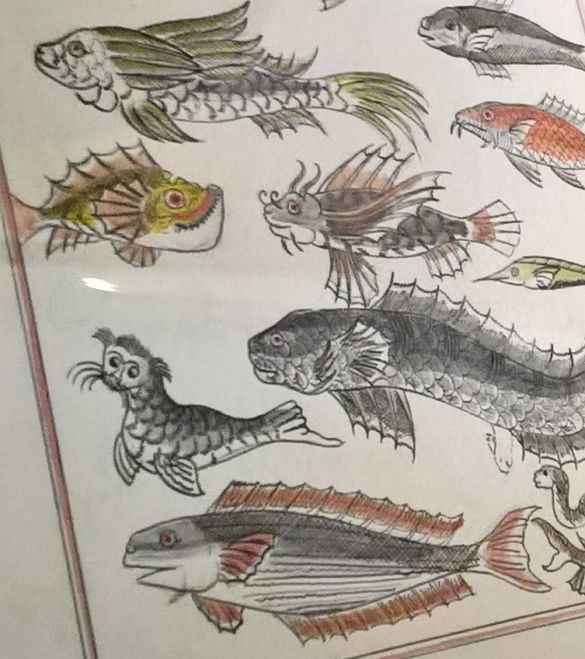
Met links een blad met prachtige vissen.
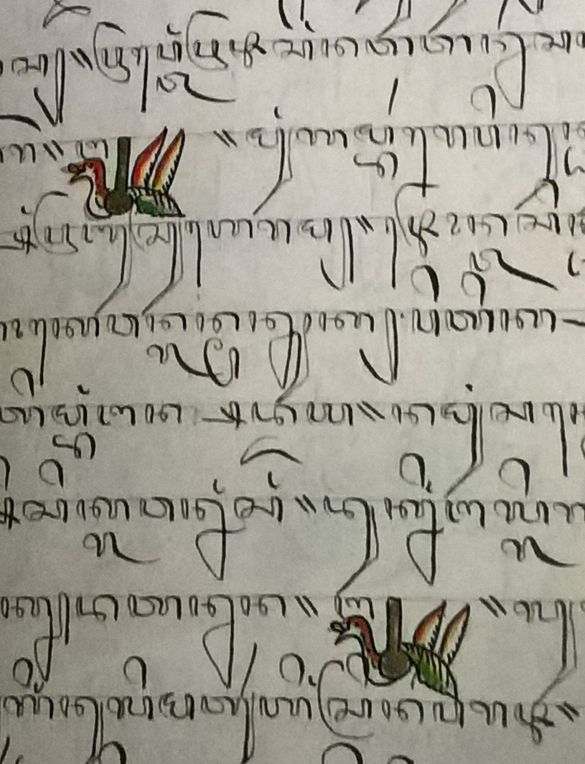
En rechts grapjes die we ook kennen uit Westerse middeleeuwse geschriften.
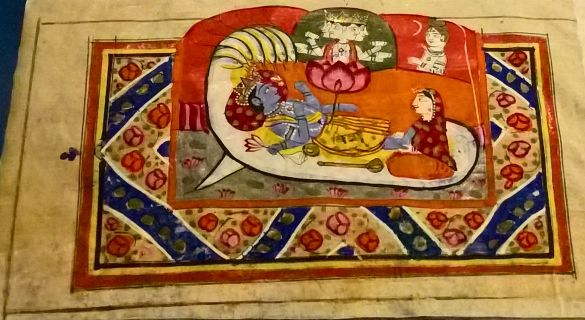
De afbeelding uit dit geillustreerde handschrift dient een beetje als het logo voor de tentoonstelling. Illuminated manuscript of the Visnusahasranama, paper, Devanagari script, North India, 19th century.
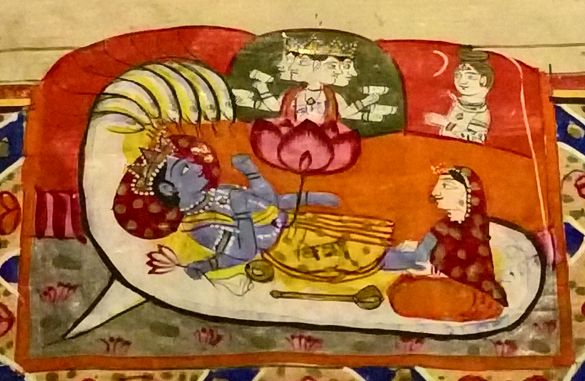
Ergens op internet (of misschien was het op de tentoonstelling) las ik wat deze afbeelding betekent. Maar helaas kan ik het niet meer vinden. Illuminated manuscript of the Visnusahasranama.
Wikipedia:
De Vishnu sahasranama is een hymne waarin de 1008 namen bezongen worden van Vishnoe, een van de belangrijkste vormen van God in het hindoeïsme en voor volgelingen van Vishnoe ook de verpersoonlijking van de Allerhoogste. De letterlijke betekenis is de 1000 namen van Vishnoe.
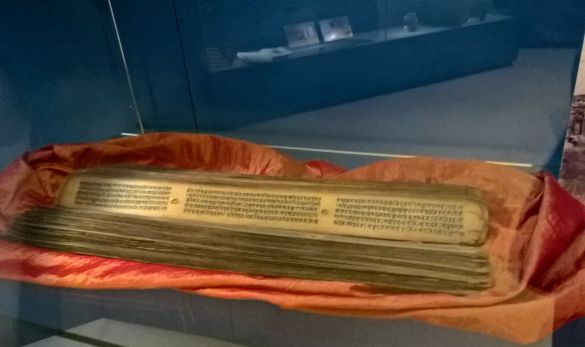
Manuscript of the Astasahasrika Prajnaparamita, palm leaf, Nepal, circa 12th century.

Manuscript of the Atthakatha of Buddhaghosa, palm leaf, Pali in Cambodian script, 19th century, gift of Prince Damrong of Siam.

De eerder genoemde leporello. Leporello manuscript of a Buddhist work on tantric ritual with 284 illustrations of Mudra (Hand-Gestures), Nepal, 19th century.
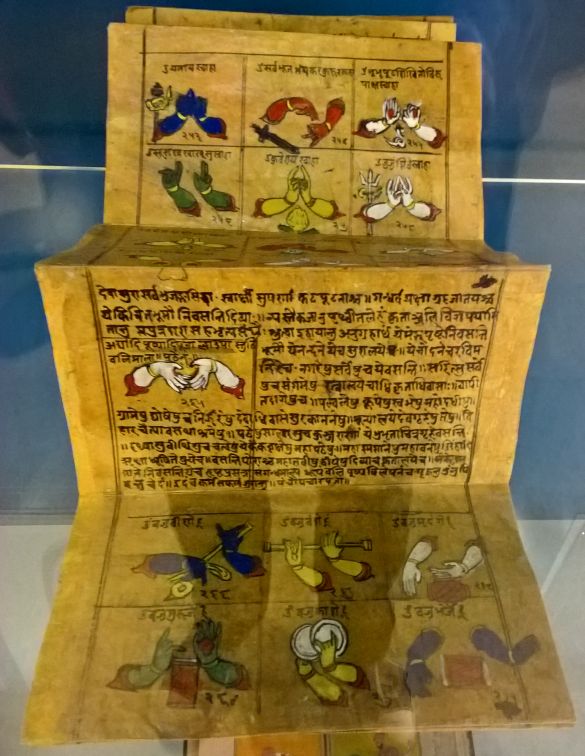
Hetzelfde document maar dan frontaal.

Het document gaat over de betekenis van de houdigen die je met je handen kunt aannemen en die zo typisch zijn voor beelden in het Boeddhisme.
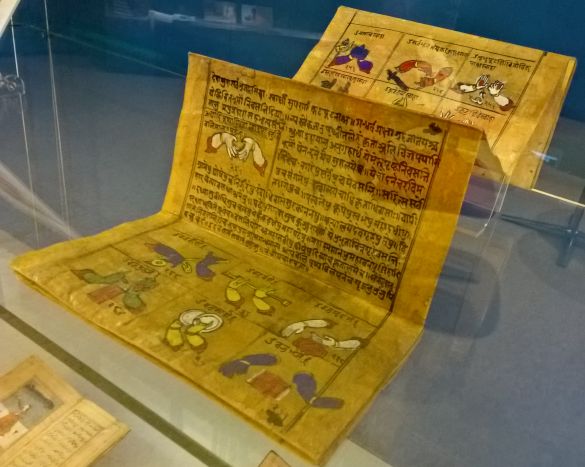
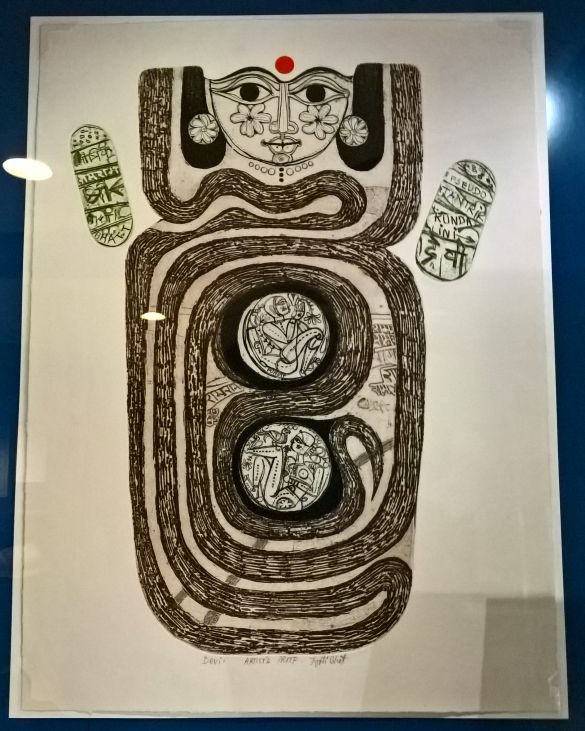
Dit lichamelijke aspect van Sanskriet komt ook terug in dit moderne werk: Etching ‘Devi’ by Jyoti Bhatt, India, 20th century. Referred to as pseudo tantric art.
Wikipedia:
Jyotindra Manshankar Bhatt (12 March 1934) Better Known as Jyoti Bhatt’, is an Indian artist best known for his modernist work in painting and printmaking and also his photographic documentation of rural Indian culture. He studied painting under N. S. Bendre and K.G. Subramanyan at the Faculty of Fine Arts, Maharaja Sayajirao University (M.S.U.), Baroda. Later he studied fresco and mural painting at Banasthali Vidyapith in Rajasthan, and in the early 1960s went on to study at the Academia di Belle Arti in Naples, Italy, as well the Pratt Institute in New York

Prachtige tentoonstelling. Ga eens kijken zou ik zeggen.
Vind-ik-leuk Aan het laden...













































